VISIT DHAKA
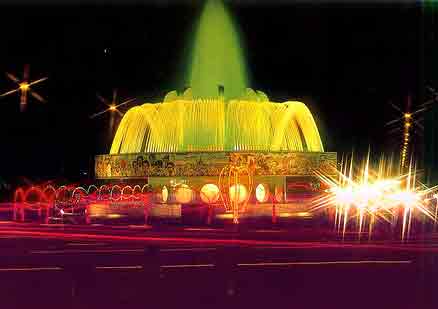 The capital of Bangladesh is Dhaka with its exciting history and rich culture Known the world over as the city of mosques and muslin. It has attracted travellers from far and near through ages. It has history dating back to earliest time. But the exact date of its foundation is not known. However, according to recorded history it was founded in 1608 A.D. as the seat of the imperial Mughal Viceroy of Bengal. The capital of Bangladesh is Dhaka with its exciting history and rich culture Known the world over as the city of mosques and muslin. It has attracted travellers from far and near through ages. It has history dating back to earliest time. But the exact date of its foundation is not known. However, according to recorded history it was founded in 1608 A.D. as the seat of the imperial Mughal Viceroy of Bengal.
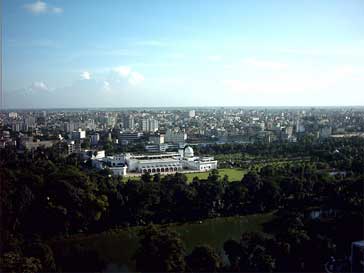 Dhaka as the capital of Bangladesh has grown into a busy city of about seven million people with an area of about 815 sq. km Having a happy blending of old and new architectural trends, Dhaka has been developing fast as a modern city and is throbbing with activities in all spheres of life. It is the centre of industrial, commercial, cultural, educational and political activities for Bangladesh. At Tongi Teigaon, Demra, Pagla, Kanchpur the industrial establishments turn-out daily necessities. Motijheel is the main commercial area of the city. Dhaka's major waterfront Sadarghat is on the bank of the river Buriganga and is crowded with all kinds of rivercraft, yatchs, country boats, motor launches, paddle - steamers, fishermen's boats all bustling with activity. Colourful rickshaws (tricycle) on the city streets are common attractions for the visitors. Some of the outstanding tourist attractions of Dhaka are: Dhaka as the capital of Bangladesh has grown into a busy city of about seven million people with an area of about 815 sq. km Having a happy blending of old and new architectural trends, Dhaka has been developing fast as a modern city and is throbbing with activities in all spheres of life. It is the centre of industrial, commercial, cultural, educational and political activities for Bangladesh. At Tongi Teigaon, Demra, Pagla, Kanchpur the industrial establishments turn-out daily necessities. Motijheel is the main commercial area of the city. Dhaka's major waterfront Sadarghat is on the bank of the river Buriganga and is crowded with all kinds of rivercraft, yatchs, country boats, motor launches, paddle - steamers, fishermen's boats all bustling with activity. Colourful rickshaws (tricycle) on the city streets are common attractions for the visitors. Some of the outstanding tourist attractions of Dhaka are:
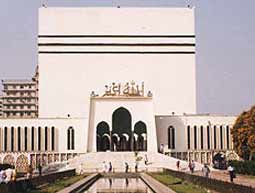 Mosque : Mosque :
Seven domed Mosque (17th century), Baitul Mukarram National Mosque, Star Mosque (18th century)
Back to the top
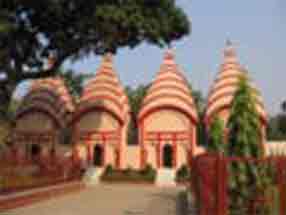 Hindu Temples : Hindu Temples :
Dhakeshwari Temple (llth Century), Ramkrishna Mission.
Back to the top
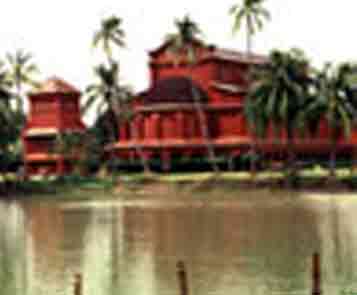 Churches : Churches :
Armenian Church (1781 A.D.) St.Mary's Cathedral at Ramna, Church of Bangladesh or former Holy Rosary Church (1677 A.D.) at Teigaon.
Back to the top
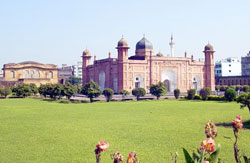 Lalbagh Fort : Lalbagh Fort :
It was built in 1678 A.D. by Prince Mohammad Azam, son of Mughal emperor Aurangazeb. The fort was the scene of bloody battle during the first war of independence (1857) when 260 sepoys stationed here backed by the people revolted against British forces. Outstanding among the monuments of the Lelbagh are the tomb of Pari Bibi (Fairy lady), Lalbagh Mosque, Audience Hall and Hammam of Nawab Shaista Khan now housing a museum.
Back to the top
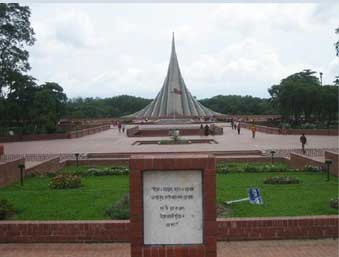 National Memorial : National Memorial :
Located at Savar, 35, km. from Dhaka city. The memorial designed by architect Moinul Hossein, is dedicated to the sacred memory of the millions of unknown martyrs of the 1971 war of liberation.
Back to the top
Mukti Juddha Museum :
Situatad at Segun Bagich a area of the city contains rare photographs of Liberation war and items used by the freedom fighters during the period.
National Museum :
Centrally located, the museum contains a large number of interesting collections including sculptures and paintings of the Hindu, Buddhist and Muslim periods.
Science Museum :
Located at Agargaon, the museum is a modern learning Centre related to the latest scientific discoveries.
Back to the top
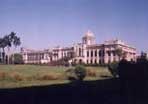 Ahsan Manzil Museum : Ahsan Manzil Museum :
On the bank of the river Buriganga in Dhaka the pink majestic Ahsan Manzil has been renovated and turned into a museum recently. It is an example of the national cultural heritage. It was the home of the Nawab of Dhaka and a Silent [spectator to many events. Today's renovated Ahsan Manzil is a monument of immense historical beauty. It has 31 rooms with a huge dome atop which can be seen from miles around. It now has 23 galleries displaying portraits, furniture and household articles and utensils used by the Nawab.
Back to the top
National Art Gallery :
Situated in the Shilpakala Academy premises this has a representative collection of folk-art and painting by artists of Bangladesh.
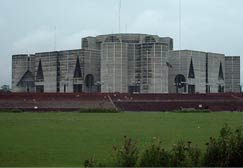 National Assembly Complex : National Assembly Complex :
Sangsad Bhaban, the National Assembly Complex in Sher-e-Bangla Nagar designed by the famous architect Luis 1. Kahn has distinctive architectural features.
Back to the top
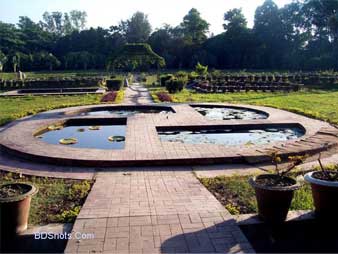 Botanical Garden : Botanical Garden :
Built over an area of 205 acres of land at Mirpur just east of the Zoo. Objective of garden-botanical education, research, preservation of plants and some recreation.
Back to the top
 Central Shahid Minar : Central Shahid Minar :
Symbol of Bengali nationalism. This monument was built to commemorate the martyrs of the historic Language movement of 1952. Hundreds and thousands of people with floral wreaths and bouquet gather on 21 February every year to pay respect in a solemn atmosphere. Celebrations begin at zero hour of midnight.
Back to the top
|

